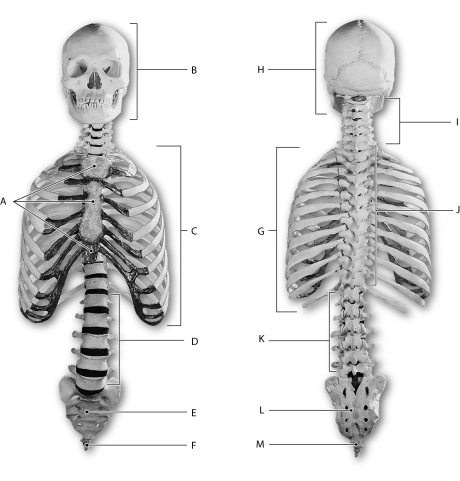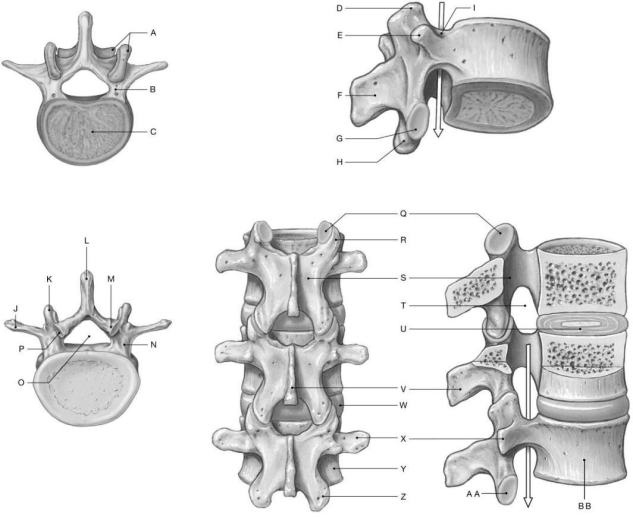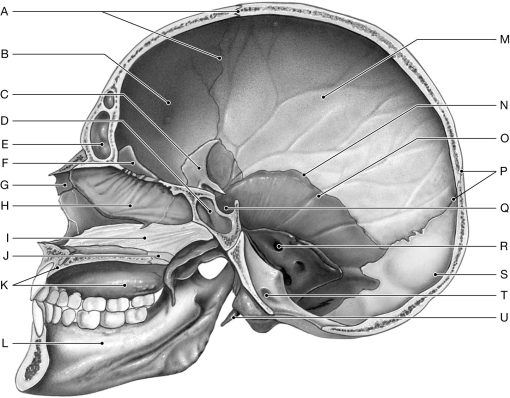Correct Answer

verified
Correct Answer
verified
True/False
The sternum serves as an anterior attachment site for the true and false ribs.
Correct Answer

verified
Correct Answer
verified
Short Answer
Figure 6.1
 Using the figure above, identify the labeled part.
-Label B: ______________________________
Using the figure above, identify the labeled part.
-Label B: ______________________________
Correct Answer

verified
Correct Answer
verified
True/False
The sphenoid bone has two condylar processes.
Correct Answer

verified
Correct Answer
verified
Short Answer
The only bone in the body that does not articulate with another bone is the ________.
Correct Answer

verified
Correct Answer
verified
Multiple Choice
The primary curvatures of the spine serves mainly to
A) accommodation of the thoracic and abdominopelvic viscera.
B) aligning the weight of the head over the legs.
C) shifting the weight of the trunk to the hips and lower extremities.
D) increasing the ability to extend the limbs.
E) take weight off of the hips.
Correct Answer

verified
Correct Answer
verified
Short Answer
Figure 6.4
 Using the figure above, identify the labeled part.
-Label W: ______________________________
Using the figure above, identify the labeled part.
-Label W: ______________________________
Correct Answer

verified
Correct Answer
verified
Multiple Choice
Which of the following bones supports some of the weight of the brain
A) frontal bones
B) lacrimal bones
C) zygomatic bones
D) parietal bones
E) ethmoid bone
Correct Answer

verified
Correct Answer
verified
Essay
The skull of a newborn often appears to be deformed, but after a short period of time, the skull assumes normal shape. What happened during the birth process and why did this change occur
Correct Answer

verified
Prior to birth, the brain enlarges rapid...View Answer
Show Answer
Correct Answer
verified
View Answer
Multiple Choice
The temporomandibular joint is
A) the location of the insertion of the temporalis muscle.
B) the suture between the temporal and maxillary bones.
C) the site of the articulation between the cranium and mandible.
D) the first suture to be completely ossified in the adult skull.
E) None of the answers are correct.
Correct Answer

verified
Correct Answer
verified
Essay
Being in car accident may cause the steering wheel to hit you very forcefully in the chest. If the damage is severe enough, the ribs may break and puncture the thoracic cavity. What is such an injury called, and what would have been the symptoms and the anatomical injuries
Correct Answer

verified
The rib would have entered the pleural c...View Answer
Show Answer
Correct Answer
verified
View Answer
Multiple Choice
Which of the following bones contain the infraorbital foramen
A) zygomatic
B) maxilla
C) frontal
D) ethmoid
E) sphenoid
Correct Answer

verified
Correct Answer
verified
Short Answer
Figure 6.3
 Using the figure above, identify the labeled part.
-Label R: ______________________________
Using the figure above, identify the labeled part.
-Label R: ______________________________
Correct Answer

verified
Internal a...View Answer
Show Answer
Correct Answer
verified
View Answer
Multiple Choice
The posterior tubercle is a part of the
A) atlas.
B) vertebra prominens.
C) anticlinal vertebra.
D) axis.
E) thoracic vertebra.
Correct Answer

verified
Correct Answer
verified
Short Answer
Figure 6.3
 Using the figure above, identify the labeled part.
-Label B: ______________________________
Using the figure above, identify the labeled part.
-Label B: ______________________________
Correct Answer

verified
Correct Answer
verified
True/False
The first cervical vertebra is the axis.
Correct Answer

verified
Correct Answer
verified
Short Answer
Figure 6.1
 Using the figure above, identify the labeled part.
-Label E: ______________________________
Using the figure above, identify the labeled part.
-Label E: ______________________________
Correct Answer

verified
Correct Answer
verified
Short Answer
Figure 6.1
 Using the figure above, identify the labeled part.
-Label G: ______________________________
Using the figure above, identify the labeled part.
-Label G: ______________________________
Correct Answer

verified
Correct Answer
verified
Short Answer
The freely movable joint in the skull occurs between the mandible and the ________ bone.
Correct Answer

verified
Correct Answer
verified
Multiple Choice
The divisions of the skeletal system include (the)
A) dorsal and ventral.
B) axial and appendicular.
C) proximal and distal.
D) cranial, caudal, and anterior.
E) None of the answers are correct.
Correct Answer

verified
Correct Answer
verified
Showing 81 - 100 of 199
Related Exams